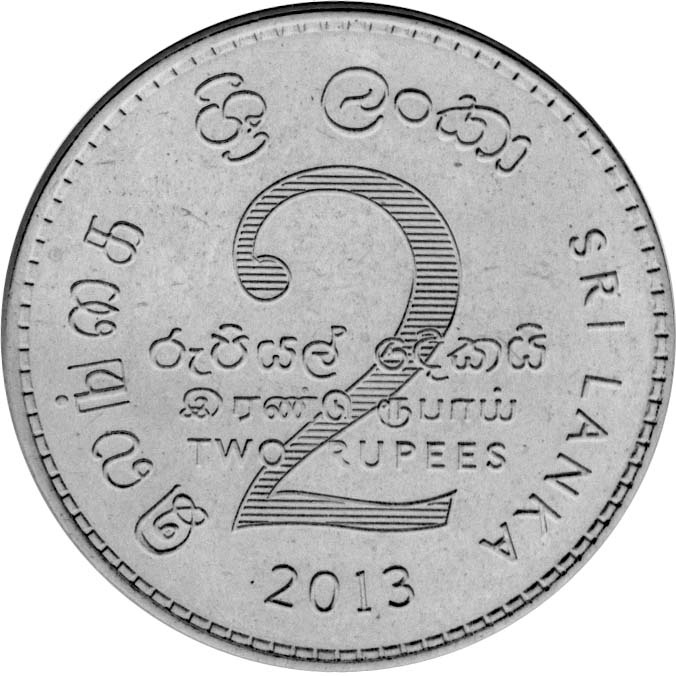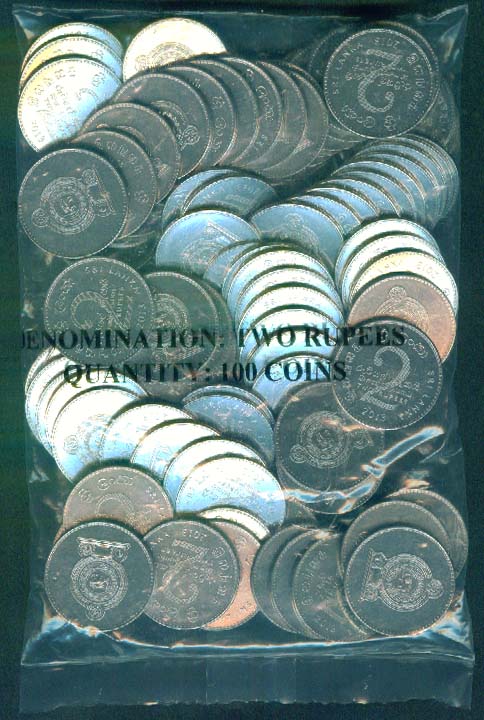| SPECIFICATIONS | |
| Denomination | Two Rupee |
| Alloy | Stainless Steel AISI 430 |
| Diameter | 28.5 mm |
| Thickness | 1.5 mm |
| Weight | 7.0 gms |
| Shape | Round |
| Edge | Milled |
| DieAxis | 0° |
| Mint | Royal Dutch Mint |


|

|

| ||||||||||||||||||||
| KM #147b | ||||||||||||||||||||||
Obverse : The Armorial Ensign of Sri Lanka within circle of dashes along periphery with raised rim.
Reverse : The large numeral denomination 2 with big
රුපියල් දෙකයි in Sinhala,
and smaller
இரண்டு ரூபாய் in Thamil
and TWO RUPEES
superimposed and year of issue at the bottom.
The country name
ශ්රී ලංකා in Sinhala, centered on top,
இலங்கை in Thamil
on left and SRI LANKA on Right. All within circle of dashes along periphery with raised rim.

In contrast to the Royal Mint Plastic bags of 1000 coins, the Royal Dutch mint coins are issued in very convenient cellophane packs of 100 coins, which weighed 700 grams on a digital scale. Printed in Black on pack is DENOMINATION: TWO RUPEES - QUANTITY: 100 COINS. Five of these packs were enclosed in a larger pack with Printed in Black DENOMINATION: TWO RUPEES - QUANTITY: 500 COINS.
This Royal Dutch mint coin has no visible differences, with the Royal Mint issue unlike the new Stainless Steel Rs10 coin from the Mincovna Kremnica in Slovak Republic also first issued in 2013.
| Year | Issue | |
| 2013 | 125,000,000 | Royal Dutch Mint |
The Koninklijke Nederlandse Munt (Royal Dutch Mint) in Utrecht, Netherlands was founded in 1567. In 2013 March it was awarded a contract by CBSL to mint 275 Million Rs2 coins over the next 3 years.
As the Dutch Mint got sold in 2016 November the 2016 order Rs 2 coin was also given to Kremnica in Slovak Republic.
The coin was scanned at 600 dpi and the images are displayed at 300 dpi. It was obtained from CBSL on 2013 November 15th.
Inspection of these 100 coins under 10x magnification showed no significat defects other than typical bag marks.
Weighing each of the 100 coins on a digital pocket scale with a precision of 0.01 grams, I found that the coins weighed between 6.89 amd 7.02 with a mean of 6.96 grams. The distribution had a rms dispersion of 0.0307 (0.441% of mean weight). It had a negative skewness of 0.367 and was platykuratic with an negative excess kurtosis of -0.49. i.e. distribution flatter than normal.
When metal sheets to cut out planchetts are rolled to get the desired thickness, then any thicker region of the sheet is rolled down. However any regions of the sheet which were thinner remain and leads to the negatively skew distribution of weights.
It appears that the coins outside this range have been removed by some weight control. This would reduce measured negative skewness and kurtosis.
This is unlike the Nickel plated Steel Rs2 coin minted at Royal Mint in 2005 which had a long tail of low weight coins as well as many error coins such as cracked die, die clashes, pits and crud (pits on die).
Rudy Boekel comments that "the Lion on this Dutch minted coin seams to
have a good mane and a visible right leg, tufs on the tail and the
sword doesn't rest against the parapet wall, face of sun and moon is
much more clearer."
Dr. Gerhard Schon informs me that nickel plated steel coins produced
at the British Royal Mint are plated before striking.
So the lower sharpness of the coins could not be because of plating.